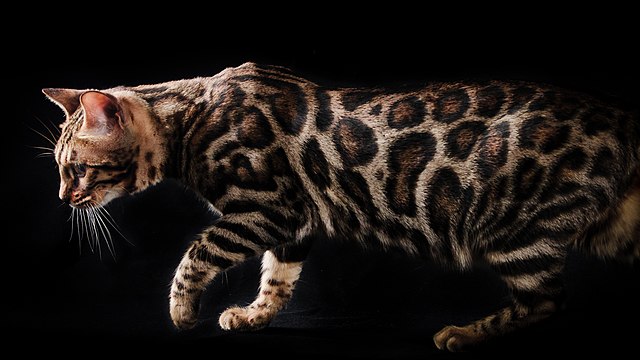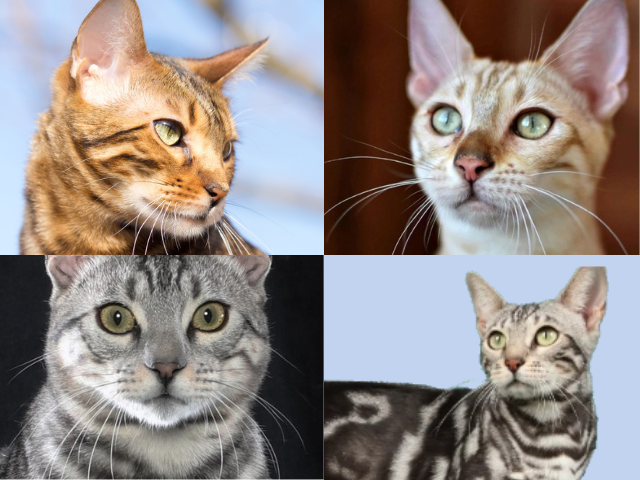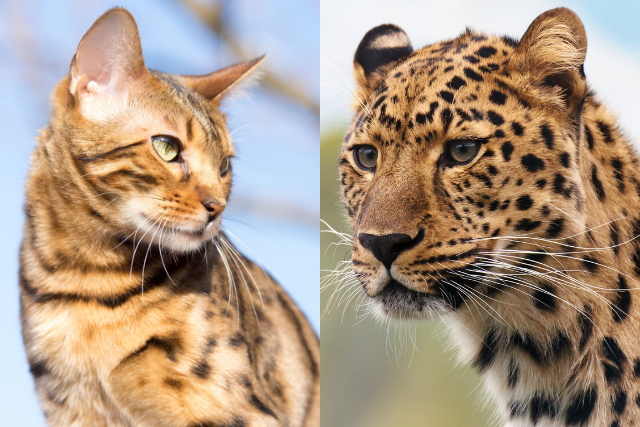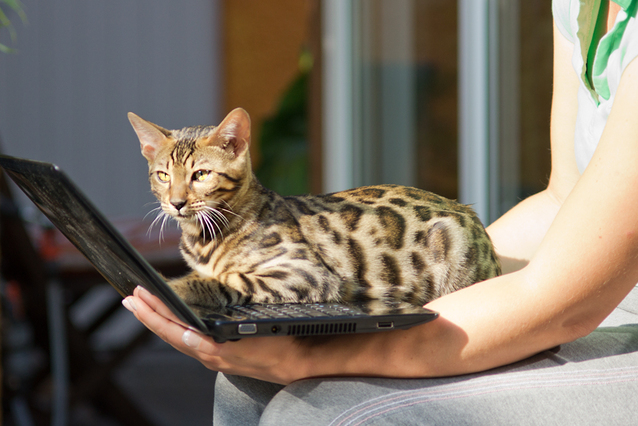The F1 Bengal Cat: These magnificent felines, with their striking coats and unique personalities very much retain a wild edge about them.
But what exactly are F1 Bengal cats, and how do they differ from their more domesticated counterparts?
This guide explores their origins, characteristics, and more…
What You Will Discover
- What defines an F1 Bengal cat
- How Bengal cats are bred
- The typical temperament of an F1 Bengal
What Is An F1 Bengal Cat?
“F1” stands for “first filial generation.”
In genetics, the term “filial generation” refers to the offspring resulting from specific crossbreeding.
An F1 Bengal cat refers to the first filial generation resulting from the direct crossbreeding between a domestic cat and an Asian leopard cat, which is a small wildcat native to Asia.
In other words, it’s the first generation offspring of a domestic cat and an Asian leopard cat.
F1 Bengal cats are typically 50% Asian leopard cat and 50% domestic cat genetically.
They often retain some wild-like traits in terms of appearance, behaviour, and temperament.
F1 Bengals may have more pronounced wild features compared to later generations, which are bred through successive Bengal-to-Bengal breeding.
These subsequent generations are typically referred to as F2, F3, and so on, depending on how many generations they are removed from the original Asian leopard cat ancestor.
Let’s now look at how Bengal cats are bred…
How Are Bengal Cats Bred?
Bengal cats are bred through a process involving careful selection and controlled breeding- initially between domestic cats and the Asian leopard cat.
In general, the breeding process follows the below steps:
Selection of Parent Cats
Breeders select domestic cats with desirable traits such as temperament, coat colour, pattern, and body structure.
These cats should ideally have no genetic health issues.
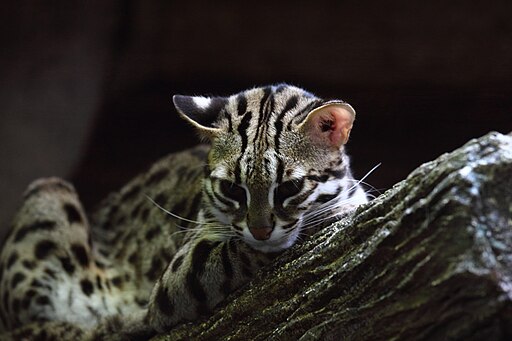
Image by paVan CC BY 2.0 via Wikimedia Commons
Additionally, Asian leopard cats used in breeding should be of good health and have desirable traits that complement those of the domestic cat.
Crossbreeding
Breeders then carefully introduce the domestic cat and the Asian leopard cat for mating.
This typically involves artificial insemination, as mating between these two species is not always successful or safe due to differences in size and behaviour.
F1 Generation
This is the first generation of kittens resulting from the cross between a domestic cat and the Asian leopard cat.
These cats are genetically typically 50% Asian leopard cat and 50% domestic cat.
Selective Breeding
From the F1 generation onwards, breeders selectively breed Bengal cats with desirable traits to produce subsequent generations with more consistent characteristics.
This involves choosing cats with preferred coat patterns (like spotted or marbled), colours, and temperaments for further breeding.
To continue the Bengal line, F1 females are bred with male domestic cats to produce F2 Bengals (second filial).
The family tree extends as follows:
Asian Leopard Cat + Domestic Mother = F1 Bengal
Domestic Father + F1 Mother = F2 Bengal
Domestic Father + F2 Mother = F3 Bengal
And so on.
Each generation moves further away from the Asian leopard cat, resulting in unique combinations of wild-like characteristics and domestic docility.
A “stud book tradition” (SBT) Bengal cat refers to an individual that is at least four generations removed from the initial domestic/Asian leopard cat cross.
A SBT Bengal cat’s lineage should be recorded in a formal pedigree or studbook.
Registration and Standards
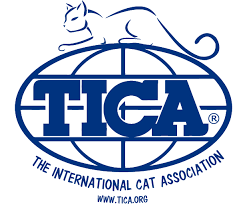
Throughout the breeding process, breeders adhere to breed standards set by cat registries such as The International Cat Association (TICA) or the Cat Fanciers’ Association (CFA).
These standards outline the ideal traits for Bengal cats in terms of appearance, temperament, and health.
Health Testing
Responsible breeders conduct health tests to screen for disorders that may be prevalent in Bengal cats.
This helps ensure the overall health and well-being of the cats being bred.
Ethical Considerations
It’s important for breeders to prioritise the welfare of the cats involved in the breeding process.
Ethical breeders provide proper care, socialisation, and medical attention to both parent cats and Bengal kittens.
Through these steps, breeders work to produce Bengal cats that not only exhibit the distinctive appearance of their wild ancestors but also possess friendly and sociable temperaments suitable for life as a household pet.
A question you may have had, which should now be clear…
Are Bengal Cats Hybrids?
Yes, as we’ve seen Bengal cats are indeed hybrids- the result of crossbreeding between domestic cats and Asian leopard cats.
The Bengal cat breed was developed through selective breeding programs that began in the 1960s and 1970s with the goal of creating a domestic cat breed with the appearance of a wild leopard but with a domesticated temperament.
Most Bengal cats available to buy as pets are results of Bengal-to-Bengal pairings, resulting in cats with reduced wild ancestry but retaining the distinctive coat patterns and traits reminiscent of their wild ancestors.
Next, a little quirk in the Bengal breeding programme is explained…
Why Are No Male Foundation Bengals Used In Breeding?
One thing you may have noticed in Bengal cat breeding programmes is that F1 females are used for further breeding, while F1 male Bengals are not.
Why is this?
Well, it’s because F1 male foundation Bengals are infertile and so cannot reproduce.
Simple.
Females also tend to have traits more desirable in pets- hence their use beyond the F1 generation.
We now know what F1 Bengals are and how they are bred, but what about temperament?
F1 Bengal Cat Temperament
The temperament of an F1 Bengal cat, as with any cat, can vary based on individual personality, genetics, socialisation, and environmental factors.
General characteristics of F1 Bengals include:
- High Energy
- Curiosity
- Affection
- Assertiveness and Dominance
- Intelligence
- Socialisation Needs
- Vocalisation
How Does The Temperament Of An F1 And SBT Bengal Cat Differ?
SBT Bengals typically exhibit a more domesticated temperament compared to F1 Bengals.
They often retain the distinctive appearance and traits of Bengal cats, such as their energetic nature, intelligence, and playfulness, but with less intensity compared to the F1 Bengal cat personality.
SBT Bengals are generally more social and affectionate towards their human companions.
They may enjoy cuddling, being petted, and interacting with family members.
Some may still have a high energy level and enjoy engaging in interactive play, but they are often more adaptable and easier to integrate into a household environment compared to an F1 cat.

Proper socialisation is still important for SBT Bengals, but they may require less intensive socialisation efforts compared to F1 Bengals.
While both F1 and SBT Bengals can make wonderful pets for the right owner, potential adopters should consider their lifestyle, experience, and preferences when choosing between the two.
So we have some idea as to how to identify an F1, but how can you be certain if buying one?
How Do I Know If My Bengal Is A F1?
If you obtained your Bengal cat from a breeder or rescue organisation, they should be able to provide you with information and documentation about the cat’s ancestry proving it to be an F1 Bengal.
If F1 Bengals are that bit more wild, can they be trained… ?
Can F1 Bengal Cats Be Trained?
Yes, F1 Bengal cats can be trained, but it may require more patience and consistency due to fact they often exhibit more ‘wild’ traits.
This can make training challenging but not impossible.
It’s important to begin training a F1 Bengal cat as early as possible.
This helps establish good habits and routines from a young age.
Each F1 Bengal cat is unique, so what works for one may not work for another.
Therefore, techniques should be adapted to suit a cat’s individual personality and needs.
If you’re still considering an F1 Bengal as a pet, you will probably want to know how much one is likely to cost…
How Much Does A F1 Bengal Cat Cost?
On average, F1 Bengal kittens will cost from between $1,000-$2,500, but prices are likely to be far higher, even double the figures stated.
Their rarity and beauty make them highly desirable pets for many people.
Keep in mind that prices can vary based on factors such as the breeder, the Bengal kitten’s lineage, coat pattern, colour, temperament, and other considerations.
It’s worth noting that the majority of breeders don’t own F1 cats and only sell SBT Bengals as pets.
Also, it may be necessary to check whether legislation in your area prevents you from owning an F1 Bengal.
It’s feeding time…
What Do F1 Bengal Cats Eat?
F1 Bengal cats have similar dietary needs to other domestic cats, in that they should be provided a high quality, animal protein rich, complete diet.
Choose a high-quality cat food that’s balanced/complete and avoids fillers, artificial additives, excessive carbohydrates or by-products.
Some owners opt to feed their F1 Bengals a raw diet, consisting of raw meat, organs, and bones with added vitamins and minerals.
However, it’s essential to do thorough research and consult with a breeder or veterinarian before switching to a raw diet, as it may pose risks such as bacterial contamination and nutritional imbalances if not properly formulated.
For more on what Bengal cats should eat see ‘Bengal Cat Food and Diet: A [Very Good] Guide‘.
Feed them appropriately and watch them grow…
How Big Do F1 Bengal Cats Get?
An F1 Bengal cat size can vary due to genetic factors and individual differences.
However, they tend to be larger and more robust than later-generation Bengal cats.
F1 Bengal cats can weigh anywhere from 10 to 20 pounds (4.5 to 9 kgs) or more, with males typically being larger than females.
Some exceptionally large F1 Bengals may exceed these figures.
Their size may also be influenced by factors such as genetics, diet, and overall health, plus the size of the Asian leopard cat and domestic cat parents.
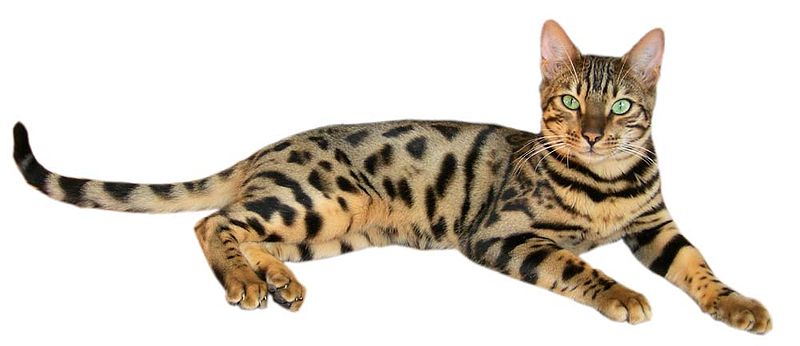
Proper nutrition and care during their development stages can contribute to them reaching their full growth potential.
If you have other pets, the next section will be of importance to you…
Do F1 Bengals Pose A Risk To Domestic Cats?
F1 Bengal cats may pose certain risks or challenges when introduced into households with other domestic cats.
These risks primarily stem from their unique background, behaviour, and potential territorial instincts.
Determining whether your Bengal kitten is an F1 typically requires examining the cat’s pedigree or lineage.
Territorial Behaviour: F1 Bengals may exhibit more pronounced territorial behaviours compared to later-generation Bengals or other domestic cat breeds.
This behaviour is inherited from their wild ancestors and may include marking, aggression, or dominance displays.
Prey Drive: F1 Bengals often retain a strong prey drive inherited from the Asian leopard cat parent.
They may view smaller pets, including other domestic cats, as prey and may exhibit hunting behaviours towards them.
Socialisation Challenges: F1 Bengals may have different socialisation needs and preferences compared to typical domestic cats.
They may be less inclined to socialise with other cats and may prefer solitary activities or interactions with humans.
Introductions and Supervision: Introducing an F1 Bengal into a household with other domestic cats requires careful planning, gradual introductions, and close supervision.
It’s essential to provide ample space, resources, and enrichment opportunities to minimize potential conflicts.
Personality Variability: Each cat’s personality is unique, and interactions between F1 Bengals and domestic cats can vary based on individual temperament and socialisation experiences.
Safety Precautions: To ensure the safety and well-being of all cats in the household, it’s crucial to monitor interactions closely, provide separate spaces for each cat to retreat to, and address any signs of stress, aggression, or conflict promptly.
Summary
This beginner’s guide covers the basic information you will need to understand what an F1 Bengal cat is, how they came to be and how they act.
If considering buying an F1 Bengal kitten it’s vitally important to know just what you’re getting into as they tend to have more ‘wild blood’ about them than lower generation, SBT Bengals.
They are likely to be hard to come by, but again, always buy from a reputable breeder and make the necessary checks to ensure you’re getting a well-rounded, healthy, genuine F1 Bengal cat.
For more on Bengals in general, see the recommended articles below:
Further Reading:
Featured Image By Fran Garcia Garcia / Creative Commons CC BY 4.0

